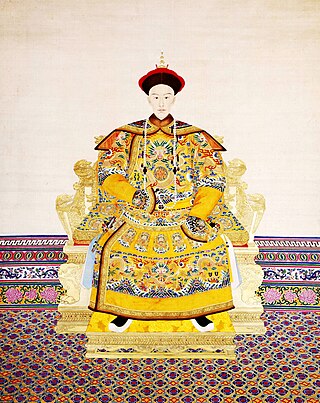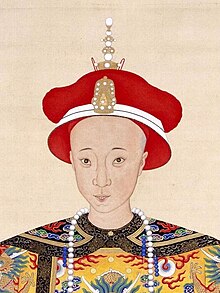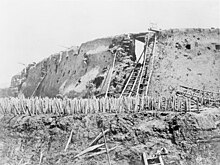
Empress Dowager Cixi ; born Yehe Nara Xingzhen, was a Chinese noblewoman of the Manchu Yehe Nara clan, concubine and later regent who effectively controlled the Chinese government in the late Qing dynasty for almost 50 years, from 1861 until her death in 1908. Selected as a concubine of the Xianfeng Emperor in her adolescence, she gave birth to a son, Zaichun, in 1856. After the Xianfeng Emperor's death in 1861, the young boy became the Tongzhi Emperor, and she assumed the role of co-empress dowager, alongside the Emperor's widow, Empress Dowager Ci'an. Cixi ousted a group of regents appointed by the late emperor and assumed the regency along with Ci'an, who later died. Cixi then consolidated control over the dynasty when she installed her nephew as the Guangxu Emperor at the death of her son, the Tongzhi Emperor, in 1875. This was contrary to the traditional rules of succession of the Qing dynasty that had ruled China since 1644.

The Guangxu Emperor, temple name Emperor Dezong of Qing, was the tenth emperor of the Qing dynasty, and the ninth Qing emperor to rule over China proper. His reign lasted from 1875 to 1908, but in practice he ruled, without his aunt Empress Dowager Cixi's influence, only from 1889 to 1898. He initiated the Hundred Days' Reform, but was abruptly stopped when the empress dowager launched a coup in 1898, after which he became powerless and was held under house arrest until his death by poisoning. His era name, 光緒; 'Guangxu', means "glorious succession".

The Tongzhi Emperor, temple name Emperor Muzong of Qing, was the ninth Emperor of the Qing dynasty, and the eighth Qing emperor to rule over China proper. His reign, from 1861 to 1875, which effectively lasted through his adolescence, was largely overshadowed by the rule of his mother, Empress Dowager Cixi. Although he had little influence over state affairs, the events of his reign gave rise to what historians call the "Tongzhi Restoration", an unsuccessful modernization program.

The Xianfeng Emperor, temple name Emperor Wenzong of Qing (清文宗), was the eighth emperor of the Qing dynasty, and the seventh Qing emperor to rule over China proper, reigned from 1850 to 1861. During his reign, the Qing dynasty experienced several wars and rebellions including the Taiping Rebellion, Nian Rebellion, and Second Opium War. He was the last Chinese emperor to exercise sole power. After his death, the Qing government came under the control of Empress Dowager Cixi.
The Hundred Days' Reform or Wuxu Reform was a failed 103-day national, cultural, political, and educational reform movement that occurred from 11 June to 22 September 1898 during the late Qing dynasty. It was undertaken by the young Guangxu Emperor and his reform-minded supporters. Following the issuing of the reformative edicts, a coup d'état ("The Coup of 1898", Wuxu Coup) was perpetrated by powerful conservative opponents led by Empress Dowager Cixi.
The Self-Strengthening Movement, also known as the Westernization or Western Affairs Movement, was a period of radical institutional reforms initiated in China during the late Qing dynasty following the military disasters of the Opium Wars.

Empress Xiaozhenxian, of the Manchu Bordered Yellow Banner Niohuru clan, was a posthumous name bestowed to the wife and empress consort of Yizhu, the Xianfeng Emperor. She was empress consort of Qing from 1852 until her husband's death in 1861, after which she was honoured as Empress Dowager Ci'an.

Zaifeng, also known as Tsai Feng, Prince of Ch'ün, formally known by his title Prince Chun, was a Manchu prince and regent of the late Qing dynasty. He was a son of Yixuan, the seventh son of the Daoguang Emperor, and the father of Puyi, the Last Emperor. He served as prince regent from 1908 to 1911 during the reign of his son until the Qing dynasty was overthrown by the Xinhai Revolution in 1911.

Yehe Nara Jingfen, of the Manchu Bordered Yellow Banner Yehe Nara clan, was the wife and empress consort of Zaitian, the Guangxu Emperor. She was empress consort of Qing from 1889 until her husband's death in 1908, after which she was honoured as Empress Dowager Longyu. She was posthumously honoured with the title Empress Xiaodingjing.

Empress Xiaozheyi, of the Manchu Bordered Yellow Banner Arute clan, was a posthumous name bestowed to the wife and empress consort of Zaichun, the Tongzhi Emperor. She was empress consort of Qing from 1872 until her husband's death in 1875, after which she was honoured as Empress Jiashun.

Ronglu, courtesy name Zhonghua, was a Manchu political and military leader of the late Qing dynasty. He was born in the Guwalgiya clan, which was under the Plain White Banner of the Manchu Eight Banners. Deeply favoured by Empress Dowager Cixi, he served in a number of important civil and military positions in the Qing government, including the Zongli Yamen, Grand Council, Grand Secretary, Viceroy of Zhili, Beiyang Trade Minister, Secretary of Defence, Nine Gates Infantry Commander, and Wuwei Corps Commander. He was also the maternal grandfather of Puyi, the last Emperor of China and the Qing dynasty.
The Tongzhi Restoration was an attempt to arrest the dynastic decline of the Qing dynasty by restoring the traditional order. The harsh realities of the Opium War, the unequal treaties, and the mid-century mass uprisings of the Taiping Rebellion caused Qing officials to recognize the need to strengthen China. The Tongzhi Restoration was named for the Tongzhi Emperor, and was engineered by the young emperor's mother, the Empress Dowager Cixi (1835–1908). The restoration, however, which applied "practical knowledge" while reaffirming the old mentality, was not a genuine program of modernization. Academics are divided as to whether the Tongzhi Restoration arrested the dynastic decline or merely delayed its inevitable occurrence.

Sigh of His Highness is a Chinese historical television series based on the life of Prince Gong, an influential Manchu prince and statesman of the late Qing dynasty. The series was directed by Li Wenlong and starred Chen Baoguo as Prince Gong. It was first broadcast on Sichuan TV in China in 2006.
The history of the Qing dynasty began in 1636, when Manchu chieftain Hong Taiji founded the dynasty, and lasted until 1912, when Puyi abdicated the throne in response to the Xinhai Revolution. The final imperial dynasty of China, the Qing dynasty reached heights of power unlike any of the Chinese dynasties which preceded it, engaging in large-scale territorial expansion which ended with embarrassing defeat and humiliation to the foreign powers whom they believe to be inferior to them. The Qing dynasty's inability to successfully counter Western and Japanese imperialism ultimately led to its downfall, and the instability which emerged in China during the final years of the dynasty ultimately paved the way for the Warlord Era.
Events from the year 1868 in China.
Events from the year 1862 in China.
Events from the year 1863 in China.
Events from the year 1865 in China.
Events from the year 1866 in China.
Events from the year 1867 in China.












